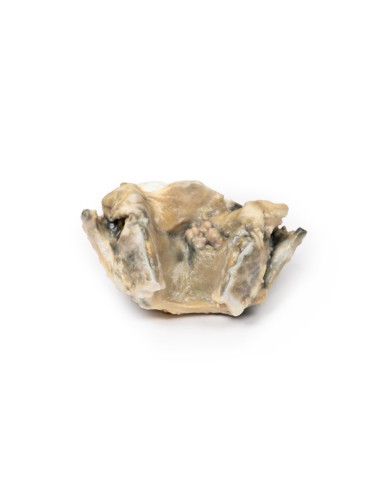Carcinoma of the larynx - Erler Zimmer 3D anatomy Series MP2052
erler zimmerMade in ultra-high resolution 3D printing in full color.
Carcinoma of the Larynx - Erler Zimmer 3D anatomy Series MP2052
This dissection model highlighting a Carcinoma of the Larynx is part of the exclusive Monash 3D anatomy series, a comprehensive series of human dissections reproduced with very high resolution color 3D printing.
Clinical History.
A 47-year-old man presents with a 13-month history of dysphonia and odinophagia at the level of the thyroid cartilage. He has a significant history of smoking. Investigation revealed a laryngeal tumor. He received radiation therapy to the tumor followed by laryngectomy. Six months later, pulmonary metastases were discovered and she subsequently died.
Pathology
This is the patient's laryngectomy specimen. The larynx was cut open and is seen from the posterior aspect. There is significant distortion of the right vocal cord by an irregular ulcerating tumor. Mucosal congestion is also noted. Histologically, it was a well-differentiated squamous cell carcinoma (SCC).
Further Information.
More than 95% of laryngeal cancers are SCC. The tumor usually develops on the vocal cords but can occur above or below the cords themselves, on the epiglottis, on the aireepiglottic folds, or in the pyriform sinuses. The cancer usually begins as carcinoma in situ, progresses to ulcerated and fungal carcinoma with continued exposure to carcinogens.
The major risk factors for the development of laryngeal cancer are tobacco smoking and alcohol consumption. Human papilloma virus (HPV) infection, asbestos exposure and irradiation have also shown higher incidence. Males are affected more than females. It occurs more frequently in the sixth decade of life.
Laryngeal cancer can spread by invading surrounding structures, through lymphatic vessels usually to local cervical lymph nodes or hematogenous metastasis most commonly to the lungs. The most common symptoms at presentation include dysphonia, dysphagia, odinophagia, globus, and cough. Less commonly, hemoptysis, stridor, dyspnea, and halitosis may be described. Treatment varies according to the stage of the disease. Smoking and alcohol cessation are important for all stages of the disease. In the early stages of the disease, laryngeal preservation treatments may include laser therapy, microsurgery, and radiation therapy. Later stage disease treatments may involve a combination of laryngectomy, radiation therapy, and chemotherapy.
What advantages does the Monash University anatomical dissection collection offer over plastic models or plastinated human specimens?
- Each body replica has been carefully created from selected patient X-ray data or human cadaver specimens selected by a highly trained team of anatomists at the Monash University Center for Human Anatomy Education to illustrate a range of clinically important areas of anatomy with a quality and fidelity that cannot be achieved with conventional anatomical models-this is real anatomy, not stylized anatomy.
- Each body replica has been rigorously checked by a team of highly trained anatomists at the Center for Human Anatomy Education, Monash University, to ensure the anatomical accuracy of the final product.
- The body replicas are not real human tissue and therefore not subject to any barriers of transportation, import, or use in educational facilities that do not hold an anatomy license. The Monash 3D Anatomy dissection series avoids these and other ethical issues that are raised when dealing with plastinated human remains.










